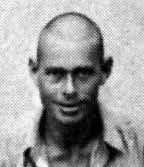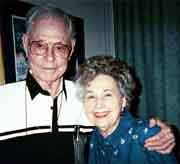Sixty
Years and Still a Champion
The Story
of the Drake Relays Champions Watch
by Roger Mansell (2002)
In the Spring of 1940, a lanky
young sophomore from the University of Texas in Austin [The Texas
"Longhorns"] anxiously awaited the start of the 480-yard
shuttle hurtle event at the Drake Relays in Des Moines, Iowa.
Numerous heats had been won to bring him to this, the final race
of the morning. Thoughts of the war in Europe faded as competitors
stretched and practiced short bursts of running, conditioning
themselves to respond to the starter's gun. The call to position
brought the men to the start line, crouched and ready to leap
ahead for the first high hurdle. With eyes focused on the first
barrier, deep breaths — seeking the last cubic inch of oxygen
— exacerbated their dry mouths. "On your marks, get
ready…"
The crack of the pistol turned all heads in the stadium as the
four-man teams raced for the title. With the arms of the final
relay man reaching up, the Longhorn hurdler lunged across the
finish line. The unranked boys whooped as they realized Texas
had swept the field.
In a formal ceremony, long forgotten in the exuberance and excitement
of the moment, the victors were presented the coveted Drake Relays
Champions Watch, a token that, like an Oscar or Tony Award, still
stands as one of the highest awards in Track and Field competition.
Within days, the team was invited to Princeton University to
challange Yale University, the winners of the prestigious Penn
Relays. Again the Texas team swept the field, not only defeating
the vaunted Yale team, but setting a new national record that
would last almost two decades. The Drake and Princeton trophies
were carried back to Texas but each man carried the personal
memento of the Drake Relays on his wrist. Owning the Drake Relays
Champions Watch, made the victories personal. As a young, six
and a half foot sophomore on a track scholarship, Ralph Baggett
savored the moment that fulfilled his dreams. He had come a long
way from his home in the small town of Hobbs, New Mexico.
Ralph chose to withdraw from college in the fall. Like many other
Americans, he joined the military rather than face the Quixotic
choices of the impending draft. For Ralph Baggett, the U.S. Marine
Corps provided a new home and, upon completion of basic training,
he was posted to Guam Island in the Marianas — a coveted
assignment along the route of the fabled Pan American Clippers
to Asia. Unfortunately, Guam lay amidst islands coveted by Japan.
On the other side of the International
Dateline, dawn had broken on Monday, December 8th, when Guam
learned of the Pearl Harbor attack. Within moments, Japanese
bombs rained down on the few Marines and sailors in Agaña
and the Marine Detachment at Sumay. The 148 Marines on Guam had
little chance of victory against an invading force of 5,500 Assault
Marines of the Imperial Japanese Army. By dawn of December 10,
1941, communication to the island of Guam ended, it's surrender
barely noted in the chaos of Pearl Harbor and the valiant struggle
of the men of Bataan and Corregidor. For Ralph Baggett, his treasured
Drake Relays Champions Watch would disappear in the looting by
the victorious Japanese.

Ralph, now a prisoner of war,
was transported to Japan and pressed into slavery for the Japanese
war effort. Arriving on January 15, 1942, the change from the
tropics to the frigid winter of Japan was the least of many worries
for the American captives. Food supplies, clothing, and medicine
were far below the standards of a civilized society. Forced to
work as slave laborers and stevedores at nearby railyards and
seaports, the spirit of the men slowly ebbed away.
After less than a month in Zentsuji, the Japanese decided to
test the physical strength of the Americans in a series of competitive
events against the "superior Japanese soldier." In
weakened condition from dysentery and severe malnutrition, the
Americans still managed to hold their own. The final test was
to be a four-man-relay race along an interior road of the camp,
the Americans against the strongest Japanese guards. The road
was approximately 175 yards in length.
"I was the third leg, " said fellow Marine Garth Dunn,
"and by the time I passed the baton to Baggett, we were
at least 25 yards behind and the cheering Japanese were happy
as hell. Within seconds, Ralph closed that gap as if the Japanese
guard was standing still and he won pulling away. God! It was
as if we won the war. Our spirits really soared."
On June 8, 1942, along with 150 fellow prisoners, Baggett was
transferred to Osaka POW camp, a crowded barracks crammed beneath
the stands of the Osaka stadium. Heavy labor on the waterfront
and rail yards, constant harassment, savage beatings, and virtual
starvation was to become their daily fare. Within days, the men
learned to survive by stealing food and, with an indomitable
spirit, Baggett and his fellow prisoners began a concerted effort
to sabotage the Japanese war effort. Holes were punched in oil
barrels, candles lit as fuses in dark corners of ships, winches
broken, sand poured into engines — an endless array of destruction.
Inevitably, they were frequently caught and the individual prisoners
savagely beaten or, just as often, subjected to mass punishments
given to the whole camp.
In early July, Baggett was seriously injured. "I was unloading
soybeans off a ship," said Baggett, "and the beans
were in huge, burlap type bags weighing over 200 pounds each
— stacked four to five high. When a stack began to fall
over, my foot was caught between two bags and I could not escape.
My knee was severely twisted and the pain was indescribable.
I lay there, unable to move, writing in pain.
"They carried me topside and I was laid out on the deck
for the rest of the day. When the shift ended, the Japanese guards
made us walk the five miles back to camp. I could not walk. Two
other POWs stayed behind to help me. I put my arms over their
shoulders, hopping on my good leg. I have no recollection who
they were but I do know I could not have made it back without
their help. By the time I got back, I literally fell unconscious
into the barracks."
Baggett, along with nine other severely injured men, was returned
to Zentsuji and, after a few days for partial recovery, was forced
back to work at the rail yards of Sakaide and the port of Takamatsu.
The diminutive Japanese took great pleasure in beating the Americans,
particularly those who were exceptionally tall. For Ralph Baggett,
his height made him the personal target of almost every guard.
"Sometime in February of 1943," said Baggett, "we
were working at the rail yards and this particular guard was
hitting lots of us over a period of days. Finally, when he hit
me, I hit him back. Unfortunately, I was seen doing this by two
other guards. I was taken back to camp where they beat the livin'
hell out of me. It was the very worst beating I've ever had —
before or since. Afterwards, they held some sort of ‘hearing'
and dumped me in the brig for nine days. It was bitterly cold
and no heat was allowed in the brig.
"I was then given a military trial and sentenced to four
months in their local penitentiary. During the farce of a trail,
I was asked if I had ‘intended to really hit him,' to which
I replied, ‘I pulled my punch deliberately. If I had really
hit him, he would have been really hurt.'"
Placed in isolation for four months on severely reduced rations,
Baggett was finally released back to the regular camp where his
fellow prisoners greeted him warmly and nursed his emaciated
body back to health.
The surrender of the Japanese on August 15, 1945, ended the suffering
of Baggett and his fellow prisoners at Zentsuji. Air drops of
food and clothing from B-29 bombers began on the 29th of August
and, finally, on September 10th, a week after the signing of
the surrender documents aboard the USS Missouri, the prisoners
of Zentsuji were freed and returned to American control.
In an interview in the fall of 2000, Baggett recalled the horrific
events of his capture and days of slavery in Japan. Now retired
and enjoying success as an artist in Granbury, Texas, Baggett
was asked, "After all the events during the war and your
successful life since, do you have any longtime regrets?"
"Yeah." he said in an emotional whisper. Slowly,
his head lowered. He leaned forward, his elbows resting upon
his spread knees while his hands joined as if in prayer. After
what seemed an eternity, he again looked up, his eyes blinking
away a tear. In a softly measured voice with a sweet southern
twang, Baggett said, "No one will ever understand but
the loss of that watch was the most bitter moment of the whole
war. It was as if my past was torn away and all I had accomplished
was erased. It was an absolutely beautiful watch and a keepsake
that represented the best of my effort. The day I won that watch
was the proudest day I ever knew."
In June of 2001, Dr. David Maxwell, the President of Drake University,
learned of the experiences of this former Drake Champion. He
immediately contacted Mark Kostek, the Director of the Drake
Relays, asking if there was a way that a replacement of this
coveted watch could be presented for Ralph's 83rd birthday in
August. Immediate efforts were made to find an original of the
1940 Drake Champions watch but to no avail.
Undaunted, and in the spirit of champions, symbolized by the
legendary Drake Relays, a 2001 Drake Relays Champions watch was
located. At last, Drake Relays Director Mark Kostek was able
to write a letter expressing the university's appreciation for
the courage and bravery of her former Drake Relays champion,
Ralph Baggett.
"It
was also brought to my attention that during captivity, the Japanese
confiscated your Drake Relays Champion Watch. We cannot tolerate
a Drake Relays Champion and a true champion of our country not
possessing his rightful award. Therefore, please allow me the
honor to present this 2001 Drake Relays Champion Watch. My only
regret is that I do not have the 1940 award at present. But in
true tradition once you are crowned a champion the title goes
with you forever.
"Thank you for your service and loyalty to our country.
Your willingness to serve, affords my family and me the freedoms
that we enjoy today.
"Congratulations on celebrating your 83rd birthday and may
you enjoy many more."
 In
Granbury, Texas, an elderly veteran sees the glory of the past
alive again on his wrist — the Drake Relays Champions Watch
— a symbol given to honor the service of a youth to his
wife Sybil, his family, his school, the Marine Corps, and his
beloved country. In
Granbury, Texas, an elderly veteran sees the glory of the past
alive again on his wrist — the Drake Relays Champions Watch
— a symbol given to honor the service of a youth to his
wife Sybil, his family, his school, the Marine Corps, and his
beloved country.
HOME Late News- Baggett
named as Grand Marshall!
|